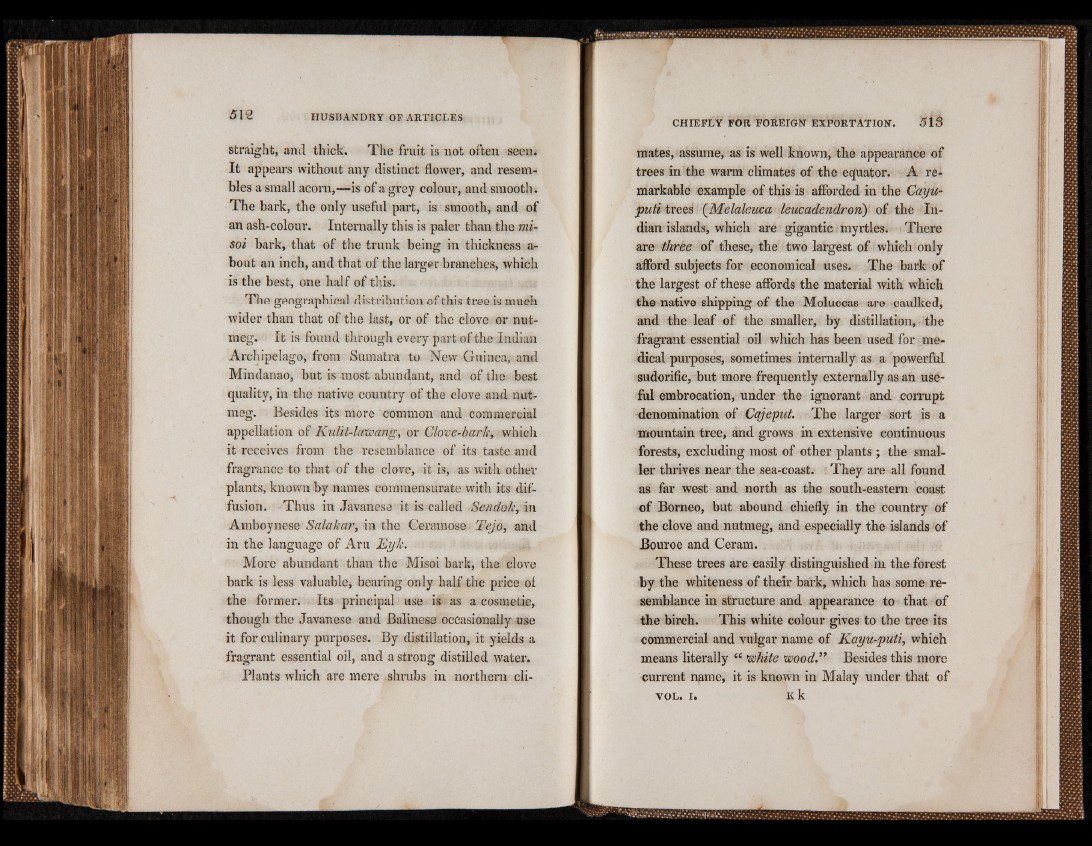
straight, and thick. The fruit is not often seen.
It appears without any distinct flower, and resembles
a small acorn,—is of a grey colour, and smooth.
The bark, the only useful part, is smooth, and of
an ash-colour. Internally this is paler than the mi-
soi bark, that of the trunk being in thickness a-
bout an inch, and that of the larger branches, which
is the best, one half of this.
The geographical distribution of this tree is much
wider than that of the last, or of the clove or nutmeg.
It is found through every part of the Indian
Archipelago, from Sumatra to New Guinea, and
Mindanao, but is most abundant, and of the best
quality, in the native country of the clove and nutmeg.
Besides its more common and commercial
appellation of Kulit-lawang, or Clove-bark, which
it receives from the resemblance of its taste and
fragrance to that of the clove, it is, as with other
plants, known by names commensurate with its diffusion.
Thus in Javanese it is called Sendolc, in
Amboynese Salakar, in the Ceramose Tejo, and
in the language of Aru Eyk.
More abundant than the Misoi bark, the clove
bark is less valuable, bearing only half the price oi
the former. Its principal use is as a cosmetic,
though the Javanese and Balinese occasionally use
it for culinary purposes. By distillation, it yields a
fragrant essential oil, and a strong distilled water.
Plants which are mere shrubs in northern climates,
assume, as is well known, the appearance of
trees in the warm climates of the equator. A remarkable
example of this is afforded in the Cayu-
puti trees {Melaleuca leucadendron) of the Indian
islands, which are gigantic myrtles. There
are three of these, the two largest of which only
afford subjects for economical uses. The bark of
the largest of these affords the material with which
the native shipping of the Moluccas are caulked,
and the leaf of the smaller, by distillation* the
fragrant essential oil which has been used for medical
purposes, sometimes internally as a powerful
sudorific, but more frequently externally as an useful
embrocation, under the ignorant and corrupt
denomination of Cajeput. The larger sort is a
mountain tree, and grows in extensive continuous
forests, excluding most of other plants ; the smaller
thrives near the sea-coast. They are all found
as far west and north as the south-eastern coast
of Borneo, but abound chiefly in the country of
the clove and nutmeg, and especially the islands of
Bouroe and Ceram.
These trees are easily distinguished in the forest
by the whiteness of their bark, which has some resemblance
in structure and appearance to that of
the birch. This white colour gives to the tree its
commercial and vulgar name of Kayu-puti, which
means literally “ white wood.” Besides this more
current name, it is known in Malay under that of
v o l . i . K k